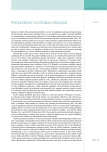Genitourinary tract infections in patient history do not correlate with prostate cancer biological behaviour and prognosis
Authors:
Jan Hrbáček 1; Michael Urban 1,5; Václav Eis 2; Eva Hamšíková 3; Ruth Tachezy 3; Marek Brabec 4; Jiří Heráček 1,5
Authors‘ workplace:
Urologická klinika 3. LF UK a FNKV, Praha
1; Ústav patologie 3. LF UK a FNKV, Praha
2; Ústav hematologie a krevní transfuze, Praha
3; Ústav informatiky Akademie věd ČR, oddělení nelineárního modelování, Praha
4; Androgeos, Praha
5
Published in:
Ces Urol 2011; 15(3): 172-180
Category:
Original article
Overview
Aim:
An association between genitourinary infection and prostate cancer has not been clearly demonstrated despite the past 20 years research efforts. No research group has investigated, however, the possible role infection could play in prostate cancer behaviour and the disease course.
Material and methods:
In our case-control study, we have evaluated 317 patients who had undergone radical retropubic prostatectomy for a clinically localized prostate cancer; we were looking for a possible correlation between the presence of antibodies (surrogate marker of past infection) to various genitourinary pathogens and the tumour biological behaviour. These sexually transmitted agents were included in the study: human cytomegalovirus, herpes simplex virus 1 and 2, human papillomavirus 6, 11, 16, 18, 31 and 33, Chlamydia trachomatis, Mycoplasma pneumoniae, Ureaplasma urealyticum, Neisseria gonorrhoeae and Treponema pallidum.
Results:
We have correlated antibody presence and serum antibody levels with the tumour clinical and pathological characteristics: local staging, Gleason score and prostatic specific antigen level. No clinically significant differences were found.
Conclusion:
No association has been found between prostate cancer biological behaviour – i.e. its prognosis – and genitourinary infectious diseases in patient history.
Key words:
infection, prostatic neoplasms, sexually transmitted diseases, cancer staging.
Sources
1. Dušek L, Mužík J, Kubásek M, et al. Epidemiologie zhoubných nádorů v České republice (online). Masarykova univerzita 2005 (cit. 2011–5–14). Dostupný z: http://www.svod.cz/ report.php?diag=C61&type=pdf. Verze 7.0 (2007).
2. Marberger M. Prostate cancer 2008: Challenges in diagnosis and management. Eur Urol Suppl 2009; 3: 89–96.
3. Jemal A, Siegel R, Xu J, Ward E. Cancer Statistics, 2010. CA Cancer J Clin 2010; 60: 277–300.
4. Hrbáček J, Urban M, Hamsikova E, et al. Serum antibodies against genitourinary infectious agents in prostate cancer and benign prostate hyperplasia patients: a case-control study. BMC Cancer 2011; 11: 53.
5. Reiner WG, Walsh PC. An anatomical approach to the surgical management of the dorsal vein and Santorini’s plexus during radical retropubic surgery. J Urol 1979; 121: 198–200.
6. Walsh PC. Anatomic radical prostatectomy. Evolution of the surgical technique. J Urol 1998; 160: 2418–2424.
7. Montironi R, van der Kwast T, Boccon-Gibod L, Bono AV, Boccon-Gibod L. Handling and patology reporting of radical prostatectomy specimens. Eur Urol 2003; 44: 626–636.
8. Eble JN, Kauter G, Epstein JI, Sesterhenn I. Pathology and genetics of tumours of the urinary system and male genital organs (IARC/World Health Organization Classification of Tumours). Lyon, France: IARC Press 2003.
9. Epstein JI, Allsbrook WC, Amin MB, Egevad LL. ISUP Grading Committee: The 2005 International Society of Urological Pathology (ISUP) Consensus conference on Gleason grading of prostatic carcinoma. Am J Surg Pathol 2005; 29(9): 1228–1242.
10. Sobin LH, Wittekind CH. TNM Classification of Malignant Tumours, 6th Edition. New York Wiley 2002.
11. Srigley JR, Amin MB, Epstein JI, et al. Updated protocol for the examination of specimens from patients with carcinomas of the prostate gland. Arch Pathol Lab Med 2006; 130(7): 936–946.
12. Hamsikova E, Smahel M, Sapp M, et al. Correlation between the presence of anti HPV33 VLP antibodies and HPV DNA in cervical neoplasia patients. Arch Virol 1997; 142(2): 413–416.
13. von Elm E, Altman DG, Egger M, et al. The Strengthening the Reporting of Observational Studies in Epidemiology (STROBE) statement: guidelines for reporting observational studies. J Clin Epi 2008; 61: 344–349.
14. Heidenreich A, Bolla M, Joniau S, et al. Guidelines on Prostate Cancer. EAU 2010. s. 55. http://www.uroweb.org/gls/pdf/Prostate%20Cancer%202010%20June%2017th.pdf
15. Giuliano AR, Tortolero–Luna G, Ferrer E, et al. Epidemiology of Human Papillomavirus Infection in Men, Cancers otherthan Cervical and Benign Conditions. Vaccine 2008; 26(Suppl 10): K17–K28.
16. Jeong WJ, Park SW, Shin M, et al. Presence of HPV type 6 in dysplasia and carcinoma arising from recurrent respiratory papillomatosis. Head Neck 2009; 31(8): 1095–1101.
17. Reidy PM, Dedo HH, Rabah R, et al. Integration of human papillomavirus type 11 in recurrent respiratory papilloma–associated cancer. Laryngoscope 2004; 114: 1906–1909.
18. Porš J, Kolombo I, Hanuš T, Poršová M. Sexuálně přenosné nemoci. In: Kolombo I, Hanuš T, eds. Infekce močových cest pro praktické lékaře a specialisty. Praha: Galén 2007; 111–113.
19. Namiki K, Goodison S, Porvasnik S, et al. Persistent exposure to Mycoplasma induces malignant transformation of human prostate cells. PLoS ONE 2009; 4(9): e6872. doi:10.1371/journal. pone.0006872
20. Staras SAS, Dollard SC, Radford KW, et al. Seroprevalence of cytomegalovirus infection in the United States, 1988–1994. Clin Inf Dis 2006; 43: 1143–1151.
21. Xu F, Schillinger JA, Sternberg MR, et al. Seroprevalence and Coinfection with Herpes Simplex Virus Type 1 and Type 2 in the United States, 1988– 1994. J Infect Dis 2002; 185: 1019–1024.
22. Zprávy CEM 1998; Suppl 1: 34–36.
23. Hayes RB, Pottern LM, Strickler H, et al. Sexual behaviour, STDs and risks for prostate cancer. Br J Cancer 2000; 82(3): 718–725.
Labels
Paediatric urologist Nephrology UrologyArticle was published in
Czech Urology

2011 Issue 3
Most read in this issue
- EARLY SURGICAL MANAGEMENT OF URETERAL TRAUMA
- Contribution of laparoscopy in diagnostics and treatment of non-palpable testes
- Late secondary bleeding after percutaneus nephrolithotomy
- Prevalence of the overactive bladder symptoms among patients of urological outpatient clinics
